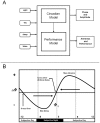Taking the lag out of jet lag through model-based schedule design
- PMID: 19543382
- PMCID: PMC2691990
- DOI: 10.1371/journal.pcbi.1000418
Taking the lag out of jet lag through model-based schedule design
Abstract
Travel across multiple time zones results in desynchronization of environmental time cues and the sleep-wake schedule from their normal phase relationships with the endogenous circadian system. Circadian misalignment can result in poor neurobehavioral performance, decreased sleep efficiency, and inappropriately timed physiological signals including gastrointestinal activity and hormone release. Frequent and repeated transmeridian travel is associated with long-term cognitive deficits, and rodents experimentally exposed to repeated schedule shifts have increased death rates. One approach to reduce the short-term circadian, sleep-wake, and performance problems is to use mathematical models of the circadian pacemaker to design countermeasures that rapidly shift the circadian pacemaker to align with the new schedule. In this paper, the use of mathematical models to design sleep-wake and countermeasure schedules for improved performance is demonstrated. We present an approach to designing interventions that combines an algorithm for optimal placement of countermeasures with a novel mode of schedule representation. With these methods, rapid circadian resynchrony and the resulting improvement in neurobehavioral performance can be quickly achieved even after moderate to large shifts in the sleep-wake schedule. The key schedule design inputs are endogenous circadian period length, desired sleep-wake schedule, length of intervention, background light level, and countermeasure strength. The new schedule representation facilitates schedule design, simulation studies, and experiment design and significantly decreases the amount of time to design an appropriate intervention. The method presented in this paper has direct implications for designing jet lag, shift-work, and non-24-hour schedules, including scheduling for extreme environments, such as in space, undersea, or in polar regions.
Conflict of interest statement
The authors have declared that no competing interests exist.
Figures






Similar articles
-
Reentrainment of the circadian pacemaker during jet lag: East-west asymmetry and the effects of north-south travel.J Theor Biol. 2018 Jan 21;437:261-285. doi: 10.1016/j.jtbi.2017.10.002. Epub 2017 Oct 4. J Theor Biol. 2018. PMID: 28987464
-
Phase-dependent effect of room light exposure in a 5-h advance of the sleep-wake cycle: implications for jet lag.J Biol Rhythms. 2002 Jun;17(3):266-76. doi: 10.1177/074873040201700310. J Biol Rhythms. 2002. PMID: 12054198
-
Optimization of light exposure and sleep schedule for circadian rhythm entrainment.PLoS One. 2021 Jun 8;16(6):e0251478. doi: 10.1371/journal.pone.0251478. eCollection 2021. PLoS One. 2021. PMID: 34101742 Free PMC article.
-
Jet Lag and Shift Work Disorder.Sleep Med Clin. 2015 Dec;10(4):523-35. doi: 10.1016/j.jsmc.2015.08.006. Epub 2015 Sep 26. Sleep Med Clin. 2015. PMID: 26568127 Review.
-
Hormonal and pharmacological manipulation of the circadian clock: recent developments and future strategies.Sleep. 2000 May 1;23 Suppl 3:S77-85. Sleep. 2000. PMID: 10809190 Review.
Cited by
-
Evolution of extrema features reveals optimal stimuli for biological state transitions.Sci Rep. 2018 Feb 21;8(1):3403. doi: 10.1038/s41598-018-21761-8. Sci Rep. 2018. PMID: 29467377 Free PMC article.
-
Applying mathematical models to predict resident physician performance and alertness on traditional and novel work schedules.BMC Med Educ. 2016 Sep 13;16(1):239. doi: 10.1186/s12909-016-0751-9. BMC Med Educ. 2016. PMID: 27623842 Free PMC article.
-
Systems Chronotherapeutics.Pharmacol Rev. 2017 Apr;69(2):161-199. doi: 10.1124/pr.116.013441. Pharmacol Rev. 2017. PMID: 28351863 Free PMC article. Review.
-
Evaluation of an automated pipeline for large-scale EEG spectral analysis: the National Sleep Research Resource.Sleep Med. 2018 Jul;47:126-136. doi: 10.1016/j.sleep.2017.11.1128. Epub 2017 Nov 29. Sleep Med. 2018. PMID: 29803181 Free PMC article.
-
Multiscale complexity in the mammalian circadian clock.Curr Opin Genet Dev. 2010 Dec;20(6):626-33. doi: 10.1016/j.gde.2010.09.006. Curr Opin Genet Dev. 2010. PMID: 20934868 Free PMC article. Review.
References
-
- Arendt J, Stone B, Skene D. Jet Lag and Sleep Disruption. In: Kryger, Roth, Dement, editors. Principles and Practice of Sleep Medicine. Philadelphia: WB Saunders; 2000. pp. 591–599.
-
- Wright KP, Jr, Hull JT, Hughes RJ, Ronda JM, Czeisler CA. Sleep and wakefulness out of phase with internal biological time impairs learning in humans. J Cogn Neurosci. 2006;18:508–521. - PubMed
-
- Wright KP, Jr, Hull JT, Czeisler CA. Relationship between alertness, performance, and body temperature in humans. Am J Physiol Regul Integr Comp Physiol. 2002;283:R1370–R1377. - PubMed
-
- Czeisler CA, Allan JS. Acute circadian phase reversal in man via bright light exposure: application to jet-lag. Sleep Res. 1987;16:605.
-
- Czeisler CA, Johnson MP, Duffy JF, Brown EN, Ronda JM, et al. Exposure to bright light and darkness to treat physiologic maladaptation to night work. N Engl J Med. 1990;322:1253–1259. - PubMed
Publication types
MeSH terms
Grants and funding
LinkOut - more resources
Full Text Sources
Other Literature Sources

